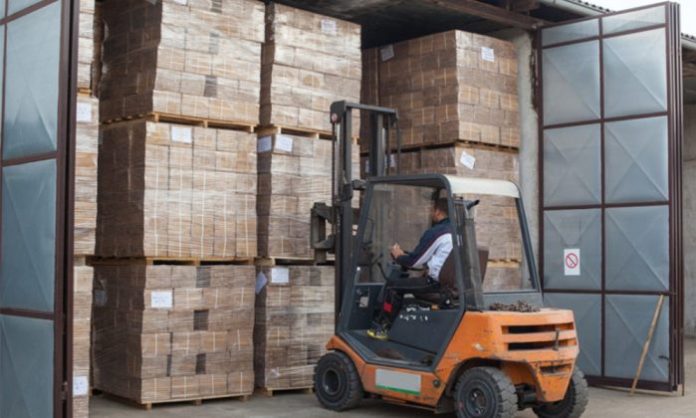Warehouse Forklift Operator Job in USA with Visa Sponsorship – Are you skilled at operating a forklift? If yes, do you know you can work in a warehouse as a warehouse forklift operator? And you can also work in the US? The warehouse Forklift Operator Job in USA with Visa Sponsorship is being offered to skilled and experienced foreigners to apply for. And alongside this job, a good salary and lots of unique benefits to give you a good employee experience is offered.
The USA is an island of opportunities for everyone both citizens and foreigners. However, there is not just one but lots of Warehouse Forklift Operator Jobs with visa sponsorship that you can apply for. So what are you waiting for? Apply for this job, take your career to the next level, get to work somewhere else aside from your own country, also earn a very good salary in a different currency, and do a lot more. What’s more? Read through to find out.
READ MORE: Forklift Driver Job in USA With Visa Sponsorship – APPLY NOW
Who is a Warehouse Forklift Operator?
A warehouse forklift operator is a person whose occupation is to operate forklift machinery in a warehouse. They ensure that every product that cannot be moved by the workers is moved using the forklift machinery. The warehouse forklift operator has the duty of ensuring that heavy goods to be lifted at the warehouse are done appropriately.
Responsibilities of a Warehouse Forklift Operator
There are several different responsibilities assigned to Warehouse Forklift Operators. And some of these responsibilities include;
- Sitting and standing forklift machinery.
- Putting in place high-risk materials.
- Assembling pallets, lumber, crates, and so on.
- Directing loads and goods into their various conveyor belts.
- Make sure your work area is clean.
Now you see that this job comes with convenient responsibilities. As a newbie to warehouse forklift operator jobs, you should go through this to know what you are to do during your working hours.
Warehouse Forklift Operator Job in USA with Visa Sponsorship Average Salary
As mentioned earlier, the pay for a warehouse forklift operator job in USA with visa sponsorship is quite high. As an entry-level Warehouse Forklift Operator, you get to earn an average salary of about $26,326 annually. While if you have experience in the job you get to earn an average salary of about $36,685 annually.
Benefits of Warehouse Forklift Operator Job in USA
Yes, visa sponsorship is a benefit for taking up this job in the US but do you know that it is not the only benefit that comes with this job? Different companies have offered a wide variety of benefits for all their workers to enjoy. These benefits are open for all provided you are a warehouse forklift operator in USA. Here are some of the benefits of being a warehouse forklift operator below;
- Dental insurance.
- Parental leave.
- Health insurance.
- 401(k).
- AD&D insurance.
- Pliable work schedule and more.

Type of Visa to Apply for Warehouse Forklift Operator Job in USA with Visa Sponsorship
To migrate to USA after getting approved for this job in USA with visa sponsorship, you need to get a certain type of visa to migrate to USA for the job. This visa can be gotten directly from your country very easily. The type of visa is called the H-2B visa. Once you get this visa, migrating will not be an issue.
READ MORE: Forklift Operator Job in USA with Visa Sponsorship
Requirements to Apply for Warehouse Forklift Operator Jobs in USA with Visa Sponsorship
Before applying for a warehouse forklift operator job in USA with visa sponsorship, you need to first ensure that you meet the requirements for the job. Different companies give different requirements to who they offer this job in USA with visa sponsorship. However, through the website of job, you can find the requirement for the job. Below, are a few general requirements for this job;
- Very good communication skills are required.
- Make sure you have a valid driver’s license.
- Have the ability to work with the safety policies and precautions.
- The ability to safely make use of forklift machinery is required
- Ensure that you can read and write well in English.
- A year of experience or over is required for the job.
- Ensure you have a high school diploma or GED.
Now that you know these requirements, you can now proceed with applying for the job you want after meeting these requirements.
Where to Find Warehouse Forklift Operator Job in USA with Visa Sponsorship
To find the warehouse forklift operator job you wish to apply for in USA with visa sponsorship, you need to check online. Through the below platforms, you can locate the job you want very easily.
All you just need to do is to make use of the platforms through your web browser to locate the job list and select what is best for you.
How to Apply for Warehouse Forklift Operator Job in USA with Visa Sponsorship
Now that you decided to apply for this job, you might need a guideline for applying for the job. Follow up the below steps to apply for the job.
- Go through your web browser to any job platform you want.
- Make use of the search to find the job you want.
- Next, select the job best for you to apply for.
- Read through the displayed description page.
- Click on the given applied button.
Now on the next page which is the company’s job site, follow up on every onscreen step to apply for the job. And ensure you provide the right details during your application.
READ MORE: Warehouse Jobs In USA With Visa Sponsorship



